Average Hourly Wage of Police Officers by State Map


Marcus Rodriguez
Historical Geography Expert
Marcus Rodriguez specializes in historical cartography and geographic data analysis. With a background in both history and geography, he brings unique...
Geographic Analysis
What This Map Shows
The "Average Hourly Wage of Police Officers by State" map presents a compelling visual representation of how police salaries vary across the United States. This map highlights the disparities in hourly wages that police officers earn, offering insights into regional economic conditions, law enforcement funding, and public safety priorities. Policymakers, academics, and citizens alike can glean valuable information from this visualization, which not only illustrates wage differences but also invites discussions about the implications of these disparities on public safety and community relations.
Deep Dive into Police Officer Salaries
Have you ever wondered why police salaries differ so dramatically from one state to another? The reasons are multifaceted and reflect a combination of factors including local economies, cost of living, and state budgets. Police officers play a crucial role in maintaining law and order, and their compensation is often tied to the financial health of the communities they serve.
Nationally, the Bureau of Labor Statistics (BLS) provides data indicating that the average hourly wage for police officers across the United States hovers around $30, but this figure can be substantially higher or lower depending on the state. For example, states like California and New York tend to offer some of the highest wages due to higher living costs and larger budgets allocated for law enforcement. In contrast, states in the Midwest or South may offer lower wages, reflecting different economic realities and budgetary constraints.
Interestingly, factors such as the size of the police department and the crime rate in a particular area can also influence salaries. Larger urban areas often have higher crime rates, which can lead to increased funding for law enforcement. Additionally, officers in urban centers may receive additional pay for hazardous duty or overtime, boosting their overall earnings. Conversely, smaller departments in rural areas may struggle to compete with these salaries, leading to challenges in recruitment and retention.
Furthermore, the educational requirements for police officers can vary by state, impacting salaries as well. States that require higher education or specialized training often offer better pay to attract qualified candidates. This creates a spectrum of compensation that reflects not only local economics but also the value placed on education within law enforcement.
Regional Analysis
When examining the map, it becomes clear that police salaries are not uniform across the United States. For instance, in the Northeast, states like Massachusetts and New Jersey show higher average wages, often exceeding $40 per hour. These states benefit from higher property taxes and more substantial state funding, which allows local governments to offer competitive salaries to attract skilled officers.
Moving to the South, states like Alabama and Mississippi report some of the lowest averages, often below $20 per hour. This disparity can be attributed to lower overall state budgets and economic challenges, which can hinder law enforcement’s ability to attract and retain talent.
The Midwest presents a mixed picture. States like Illinois and Minnesota show average wages around $30 to $35 per hour, reflecting a balance between urban centers and rural communities. Interestingly, this region has seen a push for better funding for police departments, especially in light of ongoing discussions about public safety and crime rates.
Meanwhile, the West Coast showcases a stark contrast, with California leading the pack. The average hourly wage for police officers in California can reach upwards of $50, reflecting both the high cost of living and significant investments in law enforcement. What's fascinating is that even within the same state, cities like San Francisco can offer much higher salaries than smaller towns, highlighting the importance of local economic conditions.
Significance and Impact
Understanding the variations in police officer wages across states is essential for grasping the broader implications for public safety and community relations. Higher wages can lead to better recruitment and retention of qualified officers, which in turn can enhance community trust and safety. Conversely, low salaries may result in higher turnover rates and difficulties in maintaining a well-equipped police force, potentially affecting crime rates and community perceptions of safety.
Additionally, these disparities raise important questions about funding for law enforcement and its relationship to community needs. As debates around public safety evolve, understanding the economic underpinnings of police salaries can inform discussions about resource allocation and potential reforms.
Looking forward, trends suggest that states may need to reevaluate their compensation structures for law enforcement to keep pace with rising living costs and evolving community expectations. As communities advocate for better policing practices and accountability, the relationship between officer compensation and effective law enforcement will continue to be a critical area of focus.
Overall, the "Average Hourly Wage of Police Officers by State" map serves as a crucial tool for understanding the economic landscape of law enforcement in the United States. By examining these wages in context, we can better appreciate the challenges and opportunities facing police departments across the nation.
Visualization Details
- Published
- October 29, 2025
- Views
- 8
Comments
Loading comments...